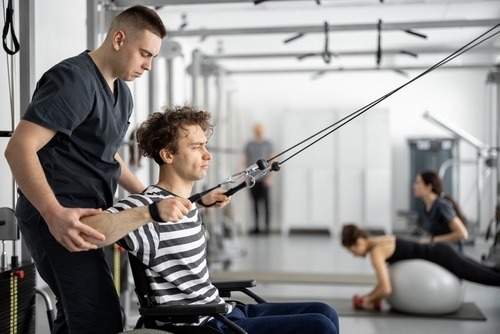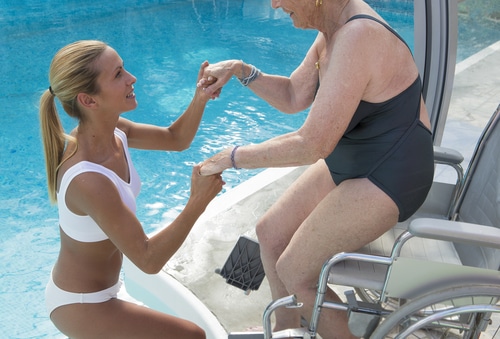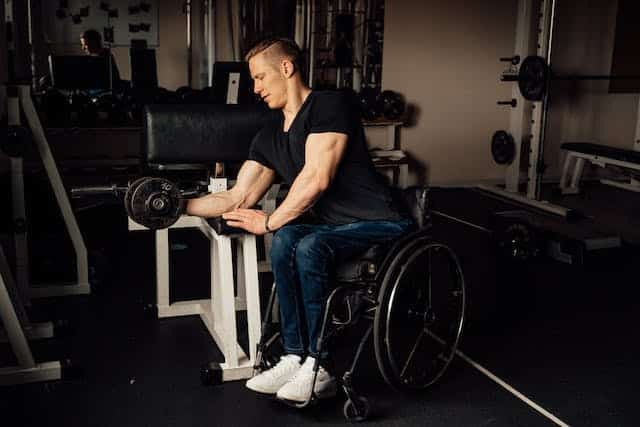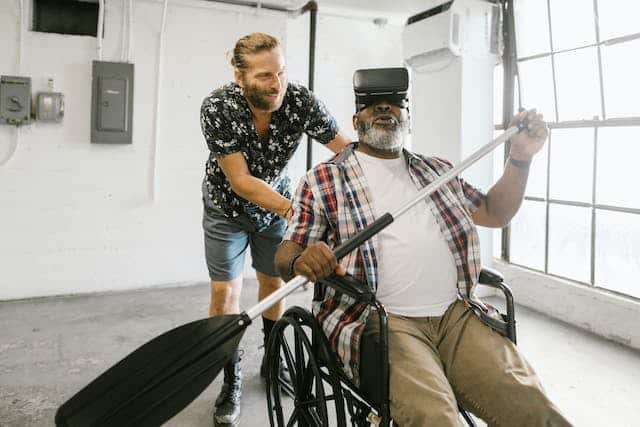Welcome to 2024! Given the New Year’s period is a time of reflection and forward planning (dare we say resolutions) we’ve rounded up some top-notch wheelchair exercises and workouts for you to explore. Getting your groove on with one or more will help you stay or become more flexible and fit, and hopefully help alleviate aches and pains.
Working out from your wheelchair can be simple, fun and exhilarating. There are lots of options to suit all levels of disability and mobility, and plenty of professional trainers to help you get into the swing of things.
Of course, it’s important to choose the appropriate type and level of exercise for your body, so we recommend speaking to your health professional or an NDIS fitness trainer to get the best recommendations. We’ve covered all this and more in this guide to wheelchair exercises and workouts.
In this article

Why is it important for wheelchair users to exercise?
Engaging in wheelchair exercises offers a multitude of benefits for both physical and mental well-being.
Importantly, these activities contribute to improved blood circulation. This ensures vital nutrients reach all parts of the body efficiently.
Regular wheelchair exercises also play a role in weight management, which helps reduce the risk of obesity, heart disease and diabetes to name a few.
Wheelchair exercises have a positive impact on cholesterol levels too, promoting great heart health. Have you had a heart health check recently? It’s important to regularly check in on how your organs are functioning, especially when you’re living with limited mobility.
And speaking of lowering your cholesterol levels, did you know that’s one of the many physical benefits of owning a pet? However, the benefits of wheelchair workouts (and pet ownership!) extend beyond the physical realm. They provide a natural boost in energy levels, aid in stress management, release tension and ease symptoms of anxiety and depression.
Embracing this win-win effort not only supports overall health but also fosters a sense of vitality and positivity in everyday life. Sounds good, right?

How do you exercise if you are in a wheelchair?
We’ve already mentioned the many health benefits of wheelchair exercise, now let’s look at some of the options to try out.
Remember we’ve also mentioned that you shouldn’t rush in without getting some perspective from a health professional. They can help you choose what’s best for you. Additionally, always warm up before you begin so that you don’t get hurt.
To get you started on ideas, read some of our disability sports guides:
Below are some ideas for wheelchair exercises that strengthen your heart, muscles, bones and joints.
Cardio exercises for wheelchair users
Cardio exercises (short for cardiovascular exercises) are movement based activities that increase your pulse, blood flow and are great for your heart. These wheelchair exercises improve your heart health, lung capacity and help you manage your weight by burning up calories. Nice!
A few examples of cardio wheelchair exercises are:
- Arm cycling
- Chair aerobics
- Water exercise
- Wheelchair rowing
- Wheelchair tennis
Read our new article on adaptive aquatics for an insight into the watery kinds of exercise. You might also enjoy our interview on the Invictus Games with adaptive sports competitor, wheelchair user and Blue Badge customer Stephen French.

Core strength exercises for wheelchair users
Wheelchair exercises for core strength training will help you build muscle tone and bone mass. Wheelchair workouts can help you improve balance, which also means reducing the risk of falls.
Some examples are:
- Resistance training
- Weight training
Flexibility wheelchair exercises
Wheelchair flexibility exercises have the potential to ward off injuries, alleviate stiffness, pain and discomfort and even expand your range of motion. A few examples are:
- Pilates
- Stretching (which can prevent, delay or even slow down muscle atrophy)
- Tai chi
- Yoga

What is the fitness test for wheelchair users?
Although there are many types of wheelchair workouts and exercises, it’s important to do the right ones for your disability. You want to strengthen without stressing or hurting your body.
In some parts of the world there’s a fitness test for wheelchair users to check muscular strength and endurance. We recommend speaking to your health support people, like your doctor and occupational therapist, to find out what wheelchair exercises work best for you.
NDIS fitness trainers to support your wheelchair exercises
You can also speak to NDIS registered fitness trainers. Here are some examples (there are many more, so do a Google search to find one near you):
Working with NDIS registered trainers might help you get your training funded. Your trainer will also be able to tailor your wheelchair exercises to give you the best of benefits.

What are the exercise guidelines for wheelchair users?
Staying active is crucial for anyone and, of course, this needs to be tailored to each person’s lifestyle and abilities. The Australian Department of Health says that “while there are no formal guidelines for people with disability and chronic conditions” the best solution is to follow “physical activity recommendations for your age group”.
We’ve outlined them here:
5 to 17 years
Children and young people should have 60 minutes or more of daily exercise or several shorter sessions of physical activities each week. For three days of the week, this should include exercises that help strengthen muscle and bone.
So, daily wheelchair exercises don’t have to happen all in one go. Having shorter spells throughout the day is just as effective as doing a full 60 minutes at once.
18 to 64 years
Adults should try to have 2.5 to 5 hours of moderate intensity activity or 1.25 to 2.5 hours of vigorous intensity activity daily, or a combination of both each week. Additionally, incorporating muscle-strengthening activities at least two days per week is advised to promote overall health and fitness.
Read about disability inclusive sports and recreation options for NDIS (and non-NDIS) participants.
65 years and over
People aged 65 and over should aim for at least 30 minutes of moderate intensity wheelchair exercise on most, if not all, days. If you’ve not been exercising, there’s no need to start doing 30 minutes all in one. Rather, begin with 10 minutes of wheelchair workouts once or twice a day and slowly increase to 15 minutes twice a day after two or more weeks.
If you can manage more than 30 minutes without putting too much stress on yourself, then that’s great. It’s also of great benefit to vary your activities throughout the week.

Keeping your wheelchair healthy too
Now that we’ve looked at wheelchair exercises and workouts to keep you healthy and fit, what about your wheelchair’s health? Did you know that you can get specialist wheelchair insurance to help pay for the costs of repairs or replacement of your chair if it’s damaged?
Have a look at the Blue Badge wheelchair insurance to find out more. We also offer mobility scooter insurance. And for those with a disability parking permit, you’re in luck – your permit gets you as much as 25% off car insurance for wheelchair accessible vehicles and disability car insurance.
Lastly, if you have an Assistance Dog or pet we’ll help keep them safe too. Get up to 25% off Assistance Dogs insurance and 15% off pet insurance with your disability parking permit.
Click below to begin a quote for any of these insurance policies.








